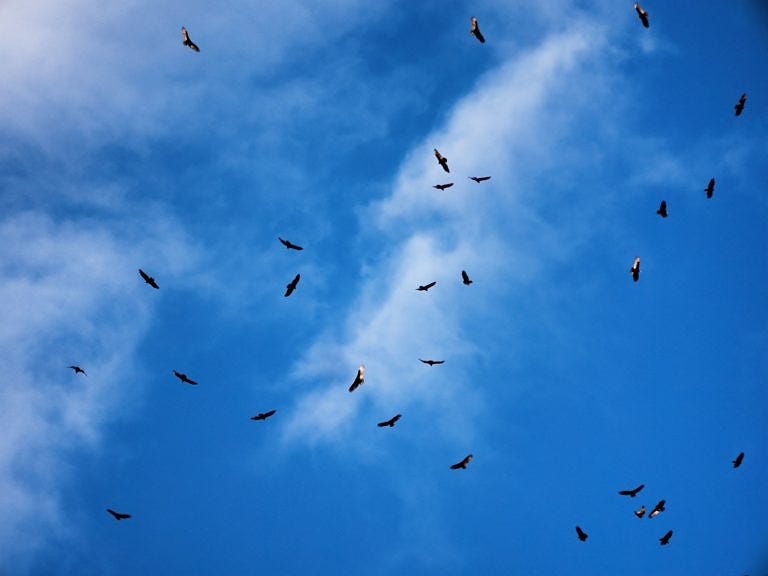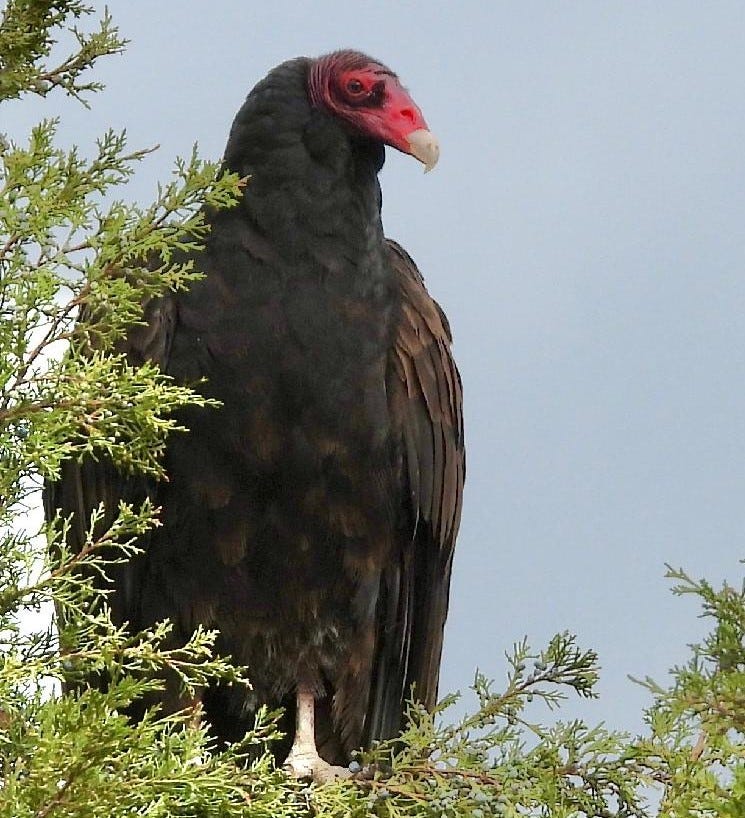Don’t judge a book …
One long-ago late afternoon in Guatemala, I was updating records of the endangered parrots our field crew was monitoring, when one of my colleagues shouted for me. I rushed out of our field station’s small office/dining area and joined my fellow biologists outside, unaware that I was about to witness a wildlife spectacle that would forever capture my imagination.
Glancing skyward, I saw a wide, black line that originated somewhere behind us and stretched across the sky as far as the eye could see. Raising my binoculars, I realized the line was composed of gliding Turkey Vultures—moving three- or four-birds abreast—in a skyborne river of birds.
“Vultures heading north!” my Guatemalan friends exclaimed. “Vultures heading home,” I smiled to myself. I’d always been on the receiving end of the Turkey Vultures’ spring migration. But here they were, journeying away from me as they headed to their breeding grounds after their winter in the tropics, moving together with singular purpose in a phenomenal aggregation.
And now, it’s early April in Montana, and I am back on the receiving end, eagerly awaiting the Turkey Vultures’ return from their winter haunts. Flying over forests and deserts, cities and farms, mountains and valleys, our migratory vultures flow north to repopulate the US and parts of southern Canada. [Click on link and press play button.]
Remembering that long-ago procession of vultures across the sky fuels my euphoria at seeing these scavenging birds return to my neighborhood each year. Finally, on April 10, I am rewarded by the sight of three Turkey Vultures floating over a field as I drive to town. They look like dark butterflies, wings held in a characteristic V, their flights wobbling slightly as these long-winged, lightweight (averaging 4 lbs.) wind-masters are buffeted by breaths of air that I cannot see.
“Welcome home, vultures!” I exclaim, as I do every year upon first seeing these stalwart migrants. “Oh, welcome home!”
As they dance on an invisible breeze, lifting my spirits, I remind myself that unlike our beloved butterfly pollinators, these birds are all too often maligned—reviled even—for their homely appearance and their distasteful habit of feeding on carrion. And yet the ecosystem services they provide are essential to humanity’s health and wellbeing.
Turkey Vultures fly relatively low to the ground, seeking out fresh carrion, which they locate with their extraordinary sense of smell—an anomaly in the bird world. In the 1930s, petroleum engineers discovered that when they added ethyl mercaptan—the same stinky substance given off by fresh carcasses—to odorless natural gas, Turkey Vultures would alert them to potential gas leaks by circling over damaged pipelines.
Covering vast distances, Turkey Vultures are quick to find and consume widely dispersed carrion. Their acidic digestive systems allow them to safely feed on animals that harbor bacteria and other disease-causing agents, preventing the spread of diseases such as botulism, rabies, anthrax, and tularemia.
The societal benefits of vultures were underscored by the recent, near-total collapse of vulture populations in much of India (three of India’s vulture species declined from a combined population of around 50 million birds in the 1980s to under 20,000 in 2017). The cause of India’s vulture die-off was a mystery for years, until a research team led by The Peregrine Fund finally discovered that vultures were dying after feeding on livestock that had been treated with a common anti-inflammatory drug (diclofenac/Voltaren), which it turned out was highly toxic to vultures. (I was sitting at a Peregrine Fund staff meeting when the researchers first announced their critically important finding.) India’s vulture declines have led to an estimated 500,000 human deaths. Water sources were contaminated by rotting carcasses, and feral dog and rat populations skyrocketed, increasing the transmission of rabies and other diseases.
Aside from playing a crucial role in removing carrion and reducing disease transmission, Turkey Vultures are intelligent, gregarious, and playful creatures. My first introduction to the species was an enchanting vulture named Vinnie that resided at a wildlife rehabilitation facility in Vermont. Vinnie liked to nibble on his caretakers’ ankles, but we could easily distract him from doing so with toys (like old sneakers and cranks used to open windows). Indeed, he was the only resident in the facility that needed toys for entertainment.
Despite their ubiquity in much of North America, Turkey Vultures are secretive when it comes to nesting. I’ve only ever found one nest site—the vultures will lay their eggs in caves, hollow logs, unoccupied hawk nests, or abandoned buildings—and I wasn’t able to see into that cliff crevice in the Grand Canyon.
Birds are key indicators of environmental health, but they have much to tell us about ourselves, too. We are all better off when we value others for their intrinsic worth rather than for their external appearance. Indeed, vultures are the embodiment of that overused idiom, “Don’t judge a book by its cover.” Riding the wind with grace, traveling vast distances, freshening our landscapes, and harboring mysteries despite its familiarity, the inimitable Turkey Vulture is worthy of celebration and deserves our appreciation—if not our affection.
Welcome home, vultures!

Take a small step to help birds
Birds are in crisis and need our help more than ever. According to the US Fish and Wildlife Service, over 96 million people in North America watch birds. If each of us does something to help them, we may be able to reverse declining bird numbers.
When people shoot ground squirrels, groundhogs, marmots, and other small animals and leave the carcasses behind, Turkey Vultures and other scavengers can be poisoned by ingesting lead shot or lead bullet fragments. Turkey Vultures can also be poisoned when they feed on deer and other large animals that have been killed by human hunters using lead bullets, which fragment into easily consumed particles. Using nonlead ammunition prevents people from consuming lead and keeps our scavengers safe. If you’re not a hunter, please warn others about the dangers of lead ammunition.
Along with aerating and enriching soils, moles, voles, and pocket gophers are critical food sources for a wide variety of animals. Using rodenticides to rid your surroundings of these creatures can indirectly harm vultures, hawks, herons, and other small-mammal consumers.
Be vigilant for wildlife (and slow down) while driving. Turkey Vultures and eagles feed on roadkill and many raptors hunt alongside roadways. These birds are vulnerable to being struck by vehicles.
Create a safe space for your local birds this nesting season. If you live in a city, pull your shades at night to make it darker for birds, pick up trash on your way to work, or volunteer to help maintain/improve a local park. If you live in a more rural area, refrain from using pesticides around your home, keep your cat inside, or plant a native shrub that will provide food and shelter for birds. If each of us does a little something extra to protect nesting birds, we might launch a larger crop of fledglings out into the world this year.
Until next time …

P.S. If you want to read more about the playful side of vultures, check out my new book Feather Trails. If you’ve already read the book, please consider leaving a rating on Amazon or Goodreads.





I too feel a burst of Joy when I spot my first turkey vultures riding the wind currents each spring. I remember Vinnie the Vulture well - despite his homely appearance, he was incredibly smart and quite the trickster! His playful nature won me over and made me a fan of vultures for life!
Thank you for that article. TV’s are my favourite I can’t wait for them to return to my area each spring. I’m in south eastern Ontario Canada. My neighbour had an abandoned barn that the vultures have returned for years. I’m fortunate to have taken pics of eggs young ones growing & fledgling ones. My place is 1/2 mile from my neighbours in the country they fly over my place as I’m sure they recognize me. They have been back for just over a month now and siblings I’m sure.